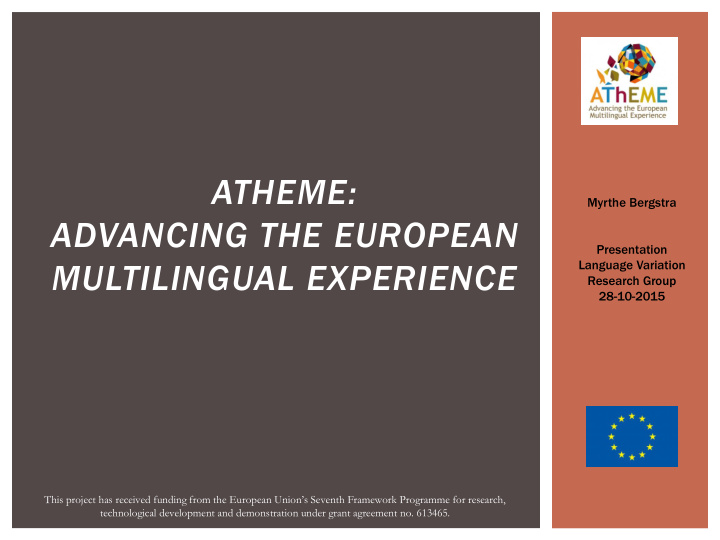



ATHEME: Myrthe Bergstra ADVANCING THE EUROPEAN Presentation MULTILINGUAL EXPERIENCE Language Variation Research Group 28-10-2015 This project has received funding from the European Union’s Seventh Framework Programme for research, technological development and demonstration under grant agreement no. 613465.
ATHEME March 2014 - March 2019 17 partner institutions across 8 European countries How does multilingualism in Europe work In the individual multilingual citizen In the multilingual group In the multilingual society
ATHEME PARTNERS Croatia Slovenia University of Rijeka Univerza v Nova Gorici France Spain CNRS Basque Centre on Cognition, Brain and Language Université de Nantes Universidad del País Vasco Germany Universidad Pompeu Fabra Universitat Konstanz United Kingdom Italy Queen Mary University of London Universita degli Studi di Verona University of Edinburgh Universita degli Studi di Trento University of Reading The Netherlands De Taalstudio KNAW (Meertens Institute) Universiteit Utrecht Universiteit Leiden
ATHEME WORK PACKAGES WP1: Project management WP2: Regional languages in multilingual Europe WP3: Heritage languages and language users in the EU WP4: Multilingualism and communicative impairment WP5: Being multilingual WP6: Dissemination Bilingualism Matters De Taalstudio (for example: Drongo Festival)
WP2: REGIONAL LANGUAGES IN MULTILINGUAL EUROPE Grammatical diversity Influence of language contact Maintenance of regional bilingualism Most partners work on syntax (Utrecht, IKER-CNRS, Trento- Verona), some on phonology (Nantes), other on attitudes (Rijeka). My focus: Syntactic variation Frisian, Dutch dialects Language contact & syntactic change
A FIRST CASE STUDY ON DUTCH-FRISIAN LANGUAGE CONTACT The verb gean (“go”) seems to change (be used in a very different syntactic context) in Frisian due to language contact with Dutch RQ 1: What is the underlying syntactic structure of different uses of gean and how does the new use arise? RQ 2: Was the change in Frisian gean induced by language contact in Dutch?
GEAN & GAAN : 3 DIFFERENT USES 1. Motion verb (physical motion) Ik gean nei Ik Amsterdam. (Former/normative) Frisian Ik Ik ga ga naar Amsterdam. . Dutch I go to Amsterdam 2. With posture verb Ik Ik gean sitten. . (Former/normative) Frisian Ik Ik ga ga zitten. . Dutch I go sit down 3. With dynamic verb (aspectual use) (Former/normative) Frisian *Ik Ik gean swimmen. Ik Ik ga ga zwemmen. . Dutch I go swim
QUESTIONNAIRE Dutch & Frisian written questionnaires Gaan/gean vs. sille/zullen + posture verb complement ( sit/stand/lie ) + dynamic verb complement ( play, run, get married , etc.) + stative verb complement ( have, be ) + modal verb complement ( will, must ) + inanimate subject ( signals functional use) Acceptability judgments (scale 1-7) Language background information
QUESTIONNAIRE RESULTS
QUESTIONNAIRE RESULTS Gean in its aspectual use (dynamic verb complements, inanimate subjects) is accepted by many Frisian speakers (but not as much as in Dutch) Gean is not accepted with modals and statives (so, not Future Tense) The aspectual use of gean is rated higher by speakers who have more contact with Dutch In short, a change seems to be going on: motion verb gean can now be used as an aspectual verb by some speakers of Frisian.
FR0M LEXICAL TO FUNCTIONAL USE A precedence relationship between 2 things can be both spatial and temporal. Therefore, gean shares features with both the lexical motion verbal position and with the Asp prospective position. However, since it also involves physical movement, it also has a [+ motion] feature. This conflicts with the features of Asp prospective , so gean could only be inserted in the V-position. Proposal: gean loses its [+motion] feature in a process of grammaticalization.
THE UNDERSPECIFICATION OF GAAN/GEAN Gaan/gean does not become a functional item, it becomes underspecified. It is semantically bleached and can be inserted in multiple contexts (motion contexts and aspectual contexts). This approach to grammaticalization explains how the different meanings of gaan/gean are related; it is just one item that is now capable of being used in both contexts
CONTACT INDUCED CHANGE? Grammaticalization of go into an aspectual marker is common cross-linguistically, so why should it be due to contact? Grammaticalization & contact induced change often go hand in hand, contact might influence a grammaticalization process (Heine & Kuteva, 2003), and Dutch and Frisian have intensive contact. Speakers who have more contact with Dutch rated the sentences with aspectual gean higher in questionnaire (but native language did not play a role!) Gean already grammaticalized in dialects which have (had) much contact with Dutch Town Frisian (Van Bree & Versloot, 2008) West-Frisian (Hoekstra, 1994)
CONCLUSION (For speakers who allow aspectual use of gean) gean lost its motion feature Therefore, it became underspecified It could then also be inserted in an Aspect prospective position There is 1 item gean, which is now bleached and flexible enough to be inserted in both positions. It seems that contact with Dutch has influenced this change
NEXT STEPS Next steps: other case studies of verbs in contact situations In which cases do we observe language change? What are the underlying structures of these changing items, what do they have in common?
Recommend
More recommend